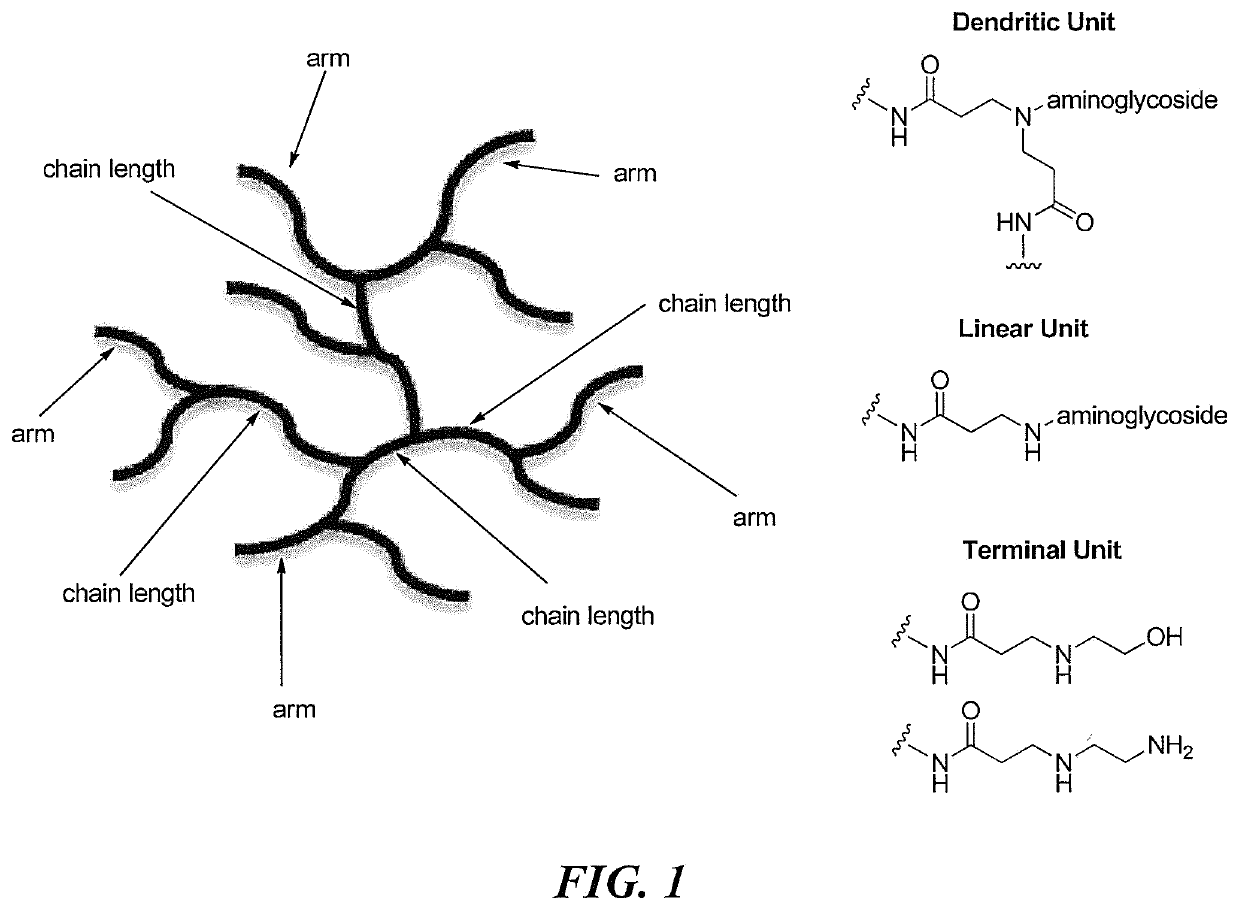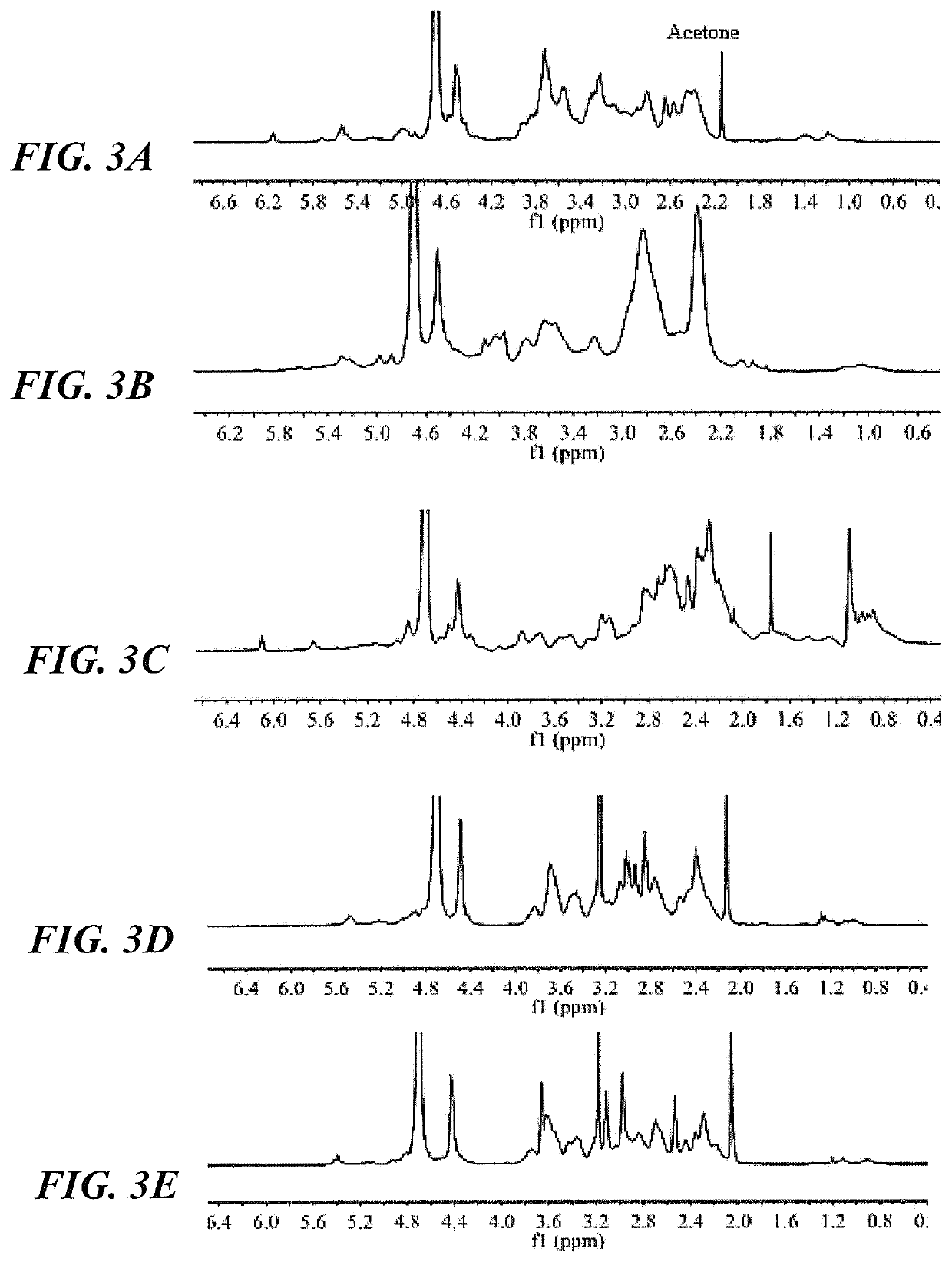Nitric oxide-releasing polyaminoglycosides as biodegradable antibacterial scaffolds and methods pertaining thereto
a technology of aminoglycosides and nitric oxide, which is applied in the field of nitric oxide-releasing hyperbranched aminoglycosides, can solve the problems of reducing affecting the survival rate of bacteria, and posing a great challenge to human health, so as to reduce the number of viable microorganisms
- Summary
- Abstract
- Description
- Claims
- Application Information
AI Technical Summary
Benefits of technology
Problems solved by technology
Method used
Image
Examples
example 1
of Certain Embodiments
1.1 Materials and Methods
[0212]Kanmycin sulfate (KA), neomycin trisulfate salt hydrate (NE), gentamicin sulfate salt (GE), N,N′-methylenebis(acrylamide) (bis-MBA), ethylene diamine (EDA), mono-ethanol amine (MEA), propidium iodide, 3-(4,5-dimethylthiazol-2-yl)-5-(3-carboxymethoxyphenyl)-2-(4-sulfophenyl)-2H-tetrazolium inner salt (MTS), and phosphate-buffered saline (PBS) for cell culture were purchased from Sigma-Aldrich (St. Louis, Mo.). 4,5-Diaminofluorescein diacetate (DAF-2DA) was purchased from Calbiochem (San Diego, Calif.). CDC anaerobe 5% sheep blood agar, brain heart infusion (BHI) broth and agar, and GasPak™ EZ campy container system sachets were purchased from Becton, Dickinson, and Company (Franklin Lakes, N.J.). Wilkins-Chalgren (W-C) broth was purchased from Acumeida Neogen Corporation (Lansing, Mich.). Human gingival fibroblast cell line and FibroLife fibroblast serum-free media were purchased from Lifeline Cell Technology LLC (Frederick, Md.). ...
example 2
e Characteristics of Certain Embodiments
[0220]Synthesis of N-diazeniumdiolate NO Donor-Modified Polysaccharides.
[0221]Macromolecular scaffolds (e.g., silica, polyamidoamine dendrimers, chitosan) for NO-release application often require additional modification steps to create reactive sites for the addition of NO donor. Hyperbranched polyaminoglycosides benefit from the existence of linear units which provide secondary amines that can be directly functionalized with N-diazeniumdiolate NO donor (or other NO donors).
[0222]To impart NO release capacity, HPAs were reacted with high pressure (10 atm) of NO under basic solution, yielding N-diazeniumdiolate NO donor-functionalized HPA (i.e., HPKA / NO, HPNE / NO, HPGE / NO, HPKA-EDA / NO, and HPKA-MEA / NO). Briefly, hyperbranched polyaminoglycosides (20 mg) were mixed with 20 μL sodium methoxide (5.4 M) in 1 mL D.I. water. The reactor was flushed with argon three times, followed by three additional longer times (10 min each) to remove oxygen. The re...
example 3
obial Characteristics of Certain Embodiments
[0228]The following describes testing that was performed using example embodiments of HPAs. The antibacterial activities of control and NO-releasing HPA were evaluated against various dental disease causing bacteria species (i.e., P. gingivalis, A. actinomycetemcomitans, A. viscosus, and S. mutans). Specifically, P. gingivalis and A. actinomycetemcomitans belong to Gram-negative class, and they are commonly related to periodontal diseases. S. mutans and A. viscosus are Gram-positive species, and they have been considered as key etiological agents for dental caries. The wide range of dental bacteria species chosen in the present disclosure ensured the potential universality of the resulting conclusion in the aspect of oral therapeutics.
Planktonic Bactericidal Assays.
[0229]Planktonic bacteria species (i.e., P. gingivalis, A. actinomycetemcomitans, S. mutans, and A. viscosus) were initially stored in 15% glycerol PBS at ˜80° C. To perform the...
PUM
| Property | Measurement | Unit |
|---|---|---|
| Fraction | aaaaa | aaaaa |
| Time | aaaaa | aaaaa |
| Density | aaaaa | aaaaa |
Abstract
Description
Claims
Application Information
 Login to view more
Login to view more - R&D Engineer
- R&D Manager
- IP Professional
- Industry Leading Data Capabilities
- Powerful AI technology
- Patent DNA Extraction
Browse by: Latest US Patents, China's latest patents, Technical Efficacy Thesaurus, Application Domain, Technology Topic.
© 2024 PatSnap. All rights reserved.Legal|Privacy policy|Modern Slavery Act Transparency Statement|Sitemap



